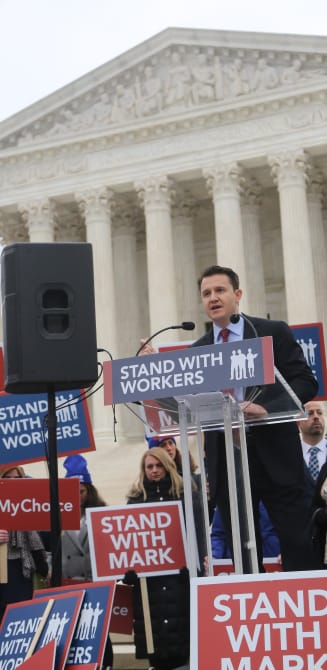Introduction
State constitutions not only structure the governments of their states and guarantee rights, they also teach about fundamental civic values and the civic ideas of our political communities. One common feature appearing in many state constitutions is the reminder that the United States of America employs federalism; it is a compound republic, assigning the federal government only limited constitutional powers intended to help protect liberty.
Many state constitutions echo something like the U.S. Constitution’s Tenth Amendment. It states that “The powers not delegated to the United States by the Constitution, nor prohibited by it to the States, are reserved to the States respectively, or to the people.” As the 250th anniversary of American Independence approaches, and as Americans lament the state of civic education in this country, those states lacking such a provision have an opportunity to mark the historic occasion by adding one.
Such provisions should reiterate that while the federal government is limited to the powers given it by the Constitution, so too are the states bound by the protections of the U.S. Constitution, such as the Bill of Rights and Fourteenth Amendment, in addition to their own state constitutions.
To that end, the Goldwater Institute offers this model state constitutional language, incorporating sections from various state constitutions that already employ such provisions:
Model State Constitutional Language Part I:
The Constitution of the United States is the supreme law of the land to which all government, state and federal, is subject.
The government of the United States is a government of enumerated powers, and all powers not delegated to it, nor inhibited to the states, are reserved to the states or to the people thereof.
Among the sovereign powers so reserved to the states is the exclusive regulation of their own internal government; but the people’s retained right of local self-government should be exercised in pursuance of law and consistently with the Constitution of the United States.
Such language would make no operational or functional change to the Constitution of Arizona or any other state that adopted it. But it would declare, as do one-fourth of current state constitutions, the principle of local self-government under the U.S. Constitution. This model amendment’s text is assembled from the U.S. Constitution’s Bill of Rights and the Declarations of Rights of several state constitutions, though state legislators could also simply adopt one of the pre-existing versions (as listed in the appendix).
Similar language appears in the constitutions of states from disparate regions and ideologies adopted at various points throughout American history, from the Founding to the admission of new states through the twentieth century. It currently appears in the constitutions of Massachusetts, New Hampshire, Vermont, Maryland, West Virginia, North Carolina, Georgia, Louisiana, Mississippi, Missouri, Texas, Colorado, Montana, and New Mexico.[2] It describes what constitutional law calls “the police power,” which refers not merely to law enforcement but to the wide power that the U.S. Constitution reserves to states to regulate the health, welfare, safety, and morals of the people, (as acknowledged even by the National Municipal League’s model state constitution, developed in the 1960s, in the wake of the New Deal and Great Society and hardly the zenith of states’ rights thought).
In some cases, states will want to add a new provision or section, as was done in Louisiana’s constitutional amendment, which added Section 26 to its Declaration of Rights in 1998. In other cases, states will want to attach it to a pre-existing section or language. For example, Arizona’s Constitution, like that of many other western states, already includes the first sentence of the model language in Article 2, Section 3A.
Refusing to Implement Unconstitutional Federal Policy
States may also wish to include an additional, second part, drawn from the Arizona Constitution, which explains and operationalizes the basic principle of constitutional law that states may not be coerced into implementing federal policy, especially unconstitutional federal policy.
(Optional) Model State Constitutional Language Part II:
B. To protect the people’s freedom and to preserve the checks and balances of the United States Constitution, this state may exercise its sovereign authority to restrict the actions of its personnel and the use of its financial resources to purposes that are consistent with the United States Constitution.
C. The legislature of this state may pass a bill [optional: or joint resolution or may refer a measure to the people pursuant to Article _] to identify any federal action or program that is inconsistent with the Constitution of the United States. This state and all political subdivisions of this state are prohibited from using any personnel or financial resources to enforce, administer, or cooperate with such federal action or programs.
This implements what foundational constitutional law—as expressed, for instance, in Sandra Day O’Connor’s opinion for the Court in New York v. United States (1992) and Antonin Scalia’s opinion for the Court in Printz v. United States (1997)—calls the anti-commandeering principle. This is a bedrock of our republic: The federal government may not dragoon the states into doing the feds’ dirty work. This principle, articulated by James Madison in Federalist 46, is doubly important when the federal government is violating the U.S. Constitution and trying to make the states take the blame. Despite possible critiques that such a declaration or action is akin to South Carolina’s stance threatening civil war in the tariff nullification crisis in the 1830s or resistance to desegregation in the 1950s, the principle of anti-commandeering is entirely different from attempts by states to simply overrule the federal government, even when it was acting lawfully under the Constitution. Rather, anti-commandeering is already a basic principle of constitutional law often invoked by states, left and right, and repeatedly blessed by the United States Supreme Court (and innumerable lower courts) as a means of faithfully upholding the framework of our constitutional republic.[3]
Reviving Federalism
Lawmakers may ask why now? As Americans celebrate the 250th anniversary of the Declaration of Independence, we might remember that it listed, among its key justifications, closure of colonial legislatures and the effort by a distant Parliament to control the local affairs of the states. This echoed previous documents from the 1760s and 1770s protesting encroachment on local sovereignty as the key early motivation for the Revolution.
This anniversary offers an opportunity for reflection on the birth of the United States and the inalienable rights of Americans, and it is imperative that these commemorations also restore an appreciation for the fundamental pillars of our country erected in the Constitution.
Perhaps even more importantly, there is also a pragmatic reason for elevating discussion of federalism and state constitutions in the present time. State lawmakers currently have an unprecedented opportunity to revive citizens’ appreciation for federalism and instill in rising generations a renewed understanding of its importance. Indeed, despite states like Arizona completely omitting the term “federalism” from their high school history and government K-12 standards, America’s youth are now uniquely poised to embrace it.[4] Why? Perhaps no episode in modern American history has demonstrated the value of federalism more directly upon students’ lives than the policies of school shutdowns in the wake of the COVID-19 pandemic. National “experts” pressed for the ongoing closure of schools—locking out millions of students throughout the country from school and social activities for two years.[5]
But America’s system of federalism enabled individual states, such as Florida, Georgia, and Arizona, to reject the top-down “expert consensus” against reopening schools, which they began doing in August 2020. If it were not for federalism and the ability of these states to govern themselves and serve as laboratories of democracy—proving to the rest of the nation that students were indeed better off when allowed to live their lives—there would have been no counter-example to the conventional wisdom—adopted as dogma in Washington, DC—that proclaimed it simply too dangerous to reopen our schools.[6]
Finally, amid the polarization and political anxieties that grip Americans during every presidential election—and often for much of the time between—federalism offers a much-needed solution to the pendulum of national politics and the fight for control of a federal government that has grown far beyond its constitutional limits. While Americans are deeply divided by love or loathing of presidents and vice presidents Joe Biden, Kamala Harris, Donald Trump, and JD Vance—or other likely future contenders for the White House, such as Gavin Newsom—nearly all Americans are now united in recognizing that, as James Madison warned, “enlightened statesmen will not always be at the helm” (Federalist 10).
Rather than consolidating ever more power over our lives in the hands of those in Washington D.C., a renewed federalism offers citizens an opportunity to live freer from the will of distant leaders and bureaucrats. From the hundreds of thousands of Americans who have flocked to conservative havens like Florida under Gov. Ron DeSantis, to their fellow countrymen who choose to remain in bastions of progressive governance like California, it is clear that America’s founders wisely recognized that a sprawling and diverse republic would best survive if organized as a system of constitutional federalism—one that protects a baseline of rights while leaving significant room for self-governance at the state and local levels.
By recommitting to our nation’s appreciation for federalism through new state constitutional amendments, state lawmakers can uphold the wisdom of James Madison, the supremacy of the Constitution, and for future generations, the prosperity of these United States.
Appendix of Illustrative Federalism Texts in Current Constitutions
U.S. Constitution: Tenth Amendment
The powers not delegated to the United States by the Constitution, nor prohibited by it to the States, are reserved to the States respectively, or to the people.
Massachusetts (1780)
Declaration of Rights, Article IV: The people of this Commonwealth have the sole and exclusive right of governing themselves as a free, sovereign, and independent State; and do, and forever hereafter shall, exercise and enjoy every power, jurisdiction, and right, which is not, or may not hereafter, be by them expressly delegated to the United States of America, in Congress assembled.
Vermont (1793)
Article 5. [Internal police]: That the people of this state by their legal representatives, have the sole, inherent, and exclusive right of governing and regulating the internal police of the same.
Maryland (1867)
Declaration of Rights, Article 3: The powers not delegated to the United States by the Constitution thereof, nor prohibited by it to the States, are reserved to the States respectively, or to the people thereof.
Declaration of Rights, Article 4: That the People of this State have the sole and exclusive right of regulating the internal government and police thereof, as a free, sovereign and independent State.
West Virginia (1872)
Article 1-2, Internal Government and Police: The government of the United States is a government of enumerated powers, and all powers not delegated to it, nor inhibited to the States, are reserved to the States or to the people thereof. Among the powers so reserved to the States is the exclusive regulation of their own internal government and police; and it is the high and solemn duty of the several departments of government, created by this Constitution, to guard and protect the people of this State from all encroachments upon the rights so reserved.
Texas (1876)
Article 1, Section 1, FREEDOM AND SOVEREIGNTY OF STATE: Texas is a free and
independent State, subject only to the Constitution of the United States, and
the maintenance of our free institutions and the perpetuity of the Union depend
upon the preservation of the right of local self-government, unimpaired to all
the States.
Colorado (1876)
Article I, Section 2 The people of this state have the sole and exclusive right of governing themselves, as a free, sovereign and independent state; and to alter and abolish their constitution and form of government whenever they may deem it necessary to their safety and happiness, provided, such change be not repugnant to the constitution of the United States.
New Mexico (1912)
Article II, Section 3: The people of the state have the sole and exclusive right to govern themselves as a free, sovereign and independent state.
Missouri (1945)
Article I, Section 3: Powers of the people over internal affairs, constitution and form of government.—That the people of this state have the inherent, sole and exclusive right to regulate the internal government and police thereof, and to alter and abolish their constitution and form of government whenever they may deem it necessary to their safety and happiness, provided such change be not repugnant to the Constitution of the United States.
Article I, Section 4: Independence of Missouri. . . .
That Missouri is a free and independent state, subject only to the Constitution of the United States; that all proposed amendments to the Constitution of the United States qualifying or affecting the individual liberties of the people or which in any wise may impair the right of local self-government belonging to the people of this state, should be submitted to conventions of the people.
North Carolina (1971)
Article I, Section 3, Internal government of the State: The people of this State have the inherent, sole, and exclusive right of regulating the internal government and police thereof, and of altering or abolishing their Constitution and form of government whenever it may be necessary to their safety and happiness; but every such right shall be exercised in pursuance of law and consistently with the Constitution of the United States.
Louisiana (1998 Amendment)
Art I, §26, State Sovereignty: The people of this state have the sole and exclusive right of governing themselves as a free and sovereign state; and do, and forever hereafter shall, exercise and enjoy every power, jurisdiction, and right, pertaining thereto, which is not, or may not hereafter be, by them expressly delegated to the United States of America in congress assembled.
Arizona (2014)
Article II, Section 3:
A. The Constitution of the United States is the supreme law of the land to which all government, state and federal, is subject.
B. To protect the people’s freedom and to preserve the checks and balances of the United States Constitution, this state may exercise its sovereign authority to restrict the actions of its personnel and the use of its financial resources to purposes that are consistent with the constitution by doing any of the following:
1. Passing an initiative or referendum pursuant to article IV, part 1, section 1.
2. Passing a bill pursuant to article IV, part 2 and article V, section 7.
3. Pursuing any other available legal remedy.
C. If the people or their representatives exercise their authority pursuant to this section, this state and all political subdivisions of this state are prohibited from using any personnel or financial resources to enforce, administer or cooperate with the designated federal action or program.
National Municipal League: Model State Constitution[7]
PREAMBLE
We, the people of the state of __________, recognizing the rights and duties of this state as a part of the federal system of government, reaffirm our adherence to the Constitution of the United States of America; and in order to assure the state government power to act for the good order of the state and the liberty, health, safety and welfare of the people, we do ordain and establish this constitution.
ARTICLE II
Powers of the State
Section 2.01. Powers of Government: The enumeration in this constitution of specified powers and functions shall be construed neither as a grant nor as a limitation of the powers of state government but the state government shall have all of the powers not denied by this constitution or by or under the Constitution of the United States.
End Notes
[1] Sean Beienburg is an Associate Professor in the School of Civic and Economic Thought and Leadership (SCETL) and director of the Arizona Constitution Project, Arizona State University. Matt Beienburg is the Director of Education Policy and of the Van Sittert Center for Constitutional Advocacy at the Goldwater Institute. The academic affiliation is provided for identification only, and this document does not represent the opinions of SCETL or Arizona State University.
[2] For a compilation of these current texts, see the appendix. For a compilation of all versions of these provisions over American history and an analysis of them, see Sean Beienburg, “Teaching Federalism: State Sovereignty Declarations in State Constitutions,” American Political Thought11 (2022): 232–52.
[3] A more recent Supreme Court case that vindicated this doctrine is Murphy v NCAA (2018), in which seven justices found all or part of a federal law unconstitutional on anti-commandeering grounds.
[4] Matt Beienburg and Corbin Witt, “Reclaiming the Constitution in K-12:
How Arizona’s Social Studies Standards Fail to Prepare Our Students for Citizenship,” Goldwater Institute, June 27, 2023, https://www.goldwaterinstitute.org/policy-report/reclaiming-the-constitution-in-k-12/.
[5] Dana Goldstein and Sarah Mervosh, “What We’ve Learned About School Closures for the Next Pandemic,” New York Times, March 13, 2025, https://www.nytimes.com/2025/03/13/us/school-closures-future-pandemic.html.
[6] Matt Beienburg, “It’s Time to Reclaim American Federalism,” Real Clear Public Affairs, November 17, 2021, https://www.realclearpublicaffairs.com/articles/2021/11/17/its_time_to_reclaim_american_federalism_803955.html.
[7] National Municipal League, “Model State Constitution,” https://texaspolitics.utexas.edu/archive/html/cons/features/0301_02/modelcons.pdf(accessed September 18, 2025).









